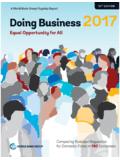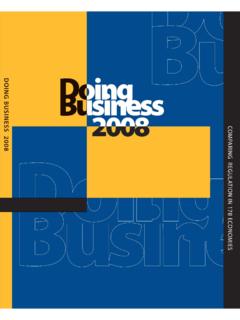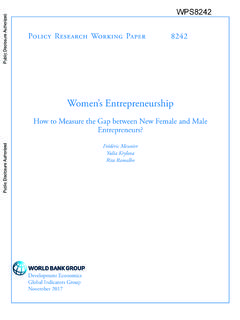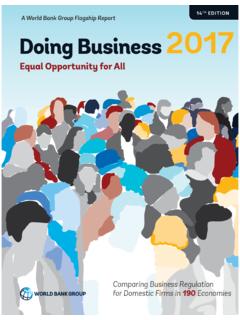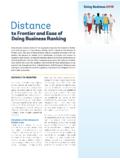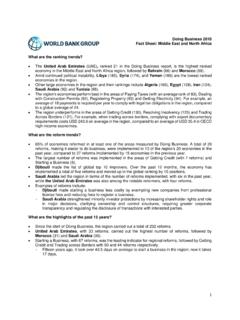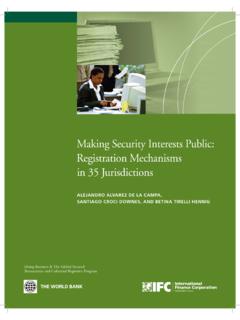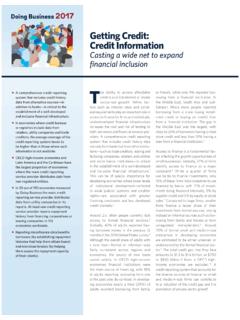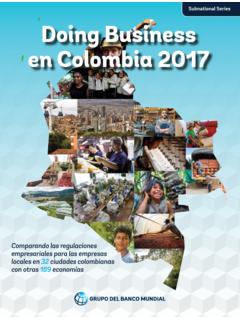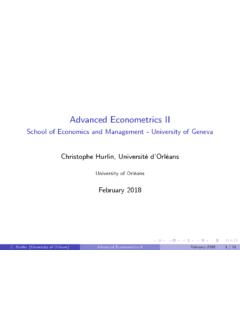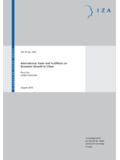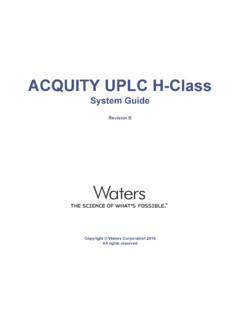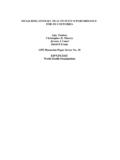Transcription of Research on the effects of business regulations
1 Doing business has provided new data on business regulations , enabling Research on them to flourish. Extensive empirical literature has assessed how the regula-tory environment for business affects a broad range of economic outcomes at both the macro and micro levels includ-ing productivity, growth, employment, trade, investment, access to finance and the informal economy. Since 2003, when this report was first published, 1,578 re-search articles discussing how regula-tions in the areas measured by Doing business influence economic outcomes have been published in peer-reviewed ac-ademic journals. Another 4,464 working papers have been posted provide some insight into the findings of this fast-growing literature, this chap-ter reviews articles published in top-rank-ing economics journals over the past 5 years or disseminated as working papers in the past 2 The chapter only cov-ers studies that use Doing business data for analysis or motivation, or else rely on conceptually and methodologically simi-lar indicators (tables and ).
2 The methodologies underpinning empiri-cal work affect the reliability of its findings and ability to influence future Research and policies. Papers in the regulatory business environment literature also vary in how much they can demonstrate caus-al effects between better business regula-tion and outcomes of interest. At one end, some studies simply docu-ment cross-country correlations between business regulatory variables and out-come variables, showing whether these variables are positively or negatively as-sociated. But such studies cannot indicate whether and how much business regula-tory variables changed outcome variables because with this method it is difficult to isolate the effects of other the other end, some studies use natural experiments, in the spirit of randomized evaluations, that to some extent control for everything else affecting the outcome variable and can isolate the causal part of this relationship (box ).
3 For example, assume that the goal is to assess how a regulatory reform affects productivity in a given economy. Simple correlations can only show whether the reform is positive-ly or negatively associated with produc-tivity. But natural experiments make it possible to see if the reform has a positive or negative impact on productivity as well as the magnitude of that impact. A methodology called difference-in-dif-ference estimation, which is similar in principle to natural experiments and is commonly used in the literature, also al-lows for the assessment of the sign and magnitude of the impact of a reform on an outcome variable (box ). Other estimation methods frequently used in economic analysis are panel data and instrumental variable analyses, which lie somewhere between pure cross-sec-tional analysis and natural experiments in terms of their ability to show wheth-er there is a causal link between vari-ables of interest.
4 Panel data include both cross-sectional and time series data for instance, a dataset that covers multiple economies over time. Such data enable researchers to control for the impact of economy-specific factors that do not vary over time, such as location. This method-ology can yield more convincing results than pure cross-sectional analysis. But in many cases, given the complexity of economic settings, they may not estab-lish causality between regulatory changes and outcomes of interest. Research on the effects of business regulations Since 2003, 1,578 Research articles using Doing business data have been published in peer-reviewed academic journals and another 4,464 have been posted online. According to the findings of the Research , reforms simplifying business registration lead to more firm creation. Nevertheless, firms that do not see the benefits of formalizing are less likely to respond to policies aimed at improving business regulations .
5 Increasing trade openness has larger effects on growth when labor markets are more flexible. Research supports the view that the cumbersome, poorly functioning regulatory business environments undermine entrepreneurship and economic performance. The introduction of collateral registries and debt recovery tribunals leads to better performing credit variable analysis allows re-searchers to establish the direction and magnitude of causality by incorporating an exogenous instrumental variable closely correlated with the variable be-ing considered (say, regulatory reform) and not with the outcome variable (say, productivity). For instance, Acemoglu, Johnson and Robinson (2002) use an instrumental variable to analyze how in-stitutions affect income per capita. Be-cause economies with strong institutions tend to have high incomes and vice ver-sa, cross-sectional or panel data analysis would not allow the authors to separate the impact of institutions on income from the impact of income on address this two-way relationship, the authors use mortality rates of European settlers as an instrument for institutions because it is closely correlated with the institutional environment in former col-onies but not with their incomes.
6 The idea is that European colonizers did not establish institutions in economies with high mortality rates. Thus the mortali-ty rates of colonizers hundreds of years ago shaped the current institutions of many economies, independent of their current incomes, making it an appropri-ate instrumental variable for institutions and allowing the authors to assess how institutions affect incomes. However, the credibility of this approach depends on the plausibility of the assumption that the instrument has no direct effect on the outcome of interest. For example, if there is a direct link between mortality rates of European settlers and current incomes (for example, through climate, which affects the disease environment), this approach will not be effective in iso-lating causal effects of institutions on ENTRY AND LABOR MARKET REGULATIONSOne of the most cited theoretical mech-anisms on how excessive business reg-ulation affects economic performance and development is that it makes it too costly for firms to engage in the formal economy, causing them not to invest or to move to the informal economy.
7 Recent studies have conducted exten-sive empirical testing of this proposition using Doing business and other related (2011, 2013), among the leading studies employing natural experiments, use quarterly national employment data collected by the Mexican government be-tween 2000 and 2004 and the fact that different regions started implementing business registration reform called Sys-tems of Fast Opening of Firms (SARE) at different times to identify how the re-form affected the occupational choices of business owners in the informal economy. Bruhn (2011) finds that reform increased the number of registered businesses by 5%, which was entirely because former wage employees started businesses not because formerly unregistered busi-nesses got registered. Bruhn (2011) also shows that the reform increased wage employment by 2% and reduced the in-come of incumbent businesses by 3% due to increased competition.
8 BOX What are randomized evaluations and natural experiments?Randomized evaluations bring experimental methods normally used in medicine or chemistry into economics. This approach tries to transform the world into a lab where researchers can clearly define control groups and treatment groups, with the treatment groups receiving interventions and control groups do not. Such experiments can be randomized by design when the choice of being part of either group is instance, when assessing how school books affect children s learning, one can design a randomized experiment where chance determines which children get books and which do not. Such experiments are almost impossible to conduct for business regulations . For example, it is impossible to randomly assign who has access to a new one-stop shop for business registration and who does not. So researchers look for natural experiments interventions not designed by them with treatment and control groups and where the rule assigning the data to the groups is unrelated to the outcome being studied.
9 This is a fundamental char-acteristic of a natural experiment because without it causal interpretation is not business regulations a control group can be formed by collecting data from, for example, cities in an economy not affected by a change in a law, regulation or economic policy, while a treatment group can be formed by collecting the same data from affected cities but otherwise identical to unaffected ones. To see if the change in a law, regulation or economic policy affected an outcome variable say, income one can assess whether the incomes of the treatment and control cities differed significantly after the change. For a causal interpretation to be possible, the treatment and control cities should have evolved similarly if the change had not been made. This assumption is unlikely to hold in most cases, making natural experiments more commonly used methodology in the literature similar in principle to natu-ral experiments and has weaker assumptions is called difference-in-difference es-timation.
10 The main difference between natural experiments and difference-in-dif-ference estimation is that in natural experiments treatment and control groups are assumed to be analogous prior to intervention and evolved similarly in the absence of intervention. In difference-in-difference estimation, these assumptions do not need to hold priori. The differences between treatment and control groups are removed by subtracting the change in means of control group from the change in means of treatment group over the time period considered in the study. The impact of intervention on outcome variable then is estimated using panel data technique and differenced ON THE effects OF business REGULATIONS31 Kaplan, Piedra and Seira (2011) use the same data from Mexico to construct a counterfactual scenario showing how quickly new firms would have been cre-ated without the business registration reform.
